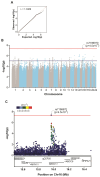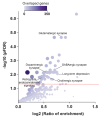Genome-Wide Insights into Internalizing Symptoms in Admixed Latin American Children
- PMID: 39858610
- PMCID: PMC11765437
- DOI: 10.3390/genes16010063
Genome-Wide Insights into Internalizing Symptoms in Admixed Latin American Children
Abstract
Background/objectives: Internalizing disorders, including depression and anxiety, are major contributors to the global burden of disease. While the genetic architecture of these disorders in adults has been extensively studied, their early-life genetic mechanisms remain underexplored, especially in non-European populations. This study investigated the genetic mechanisms underlying internalizing symptoms in a cohort of Latin American children.
Methods: This study included 1244 Brazilian children whose legal guardians completed the Child Behavior Checklist (CBCL) questionnaire. Genotyping was performed using the Illumina HumanOmni 2.5-8v1 BeadChip.
Results: The genome-wide association analysis revealed a significant association of rs7196970 (p = 4.5 × 10-8, OR = 0.61), in the ABCC1 gene, with internalizing symptoms. Functional annotation highlighted variants in epigenetically active regulatory regions, with multiple variants linked to differential expression of ABCC1 across several human tissues. Pathway enrichment analysis identified 42 significant pathways, with notable involvement in neurobiological processes such as glutamatergic, GABAergic, and dopaminergic synapses.
Conclusions: This study identifies ABCC1 variants as novel genetic factors potentially associated with early-life internalizing symptoms. These results may contribute to future research on targeted interventions for childhood internalizing conditions.
Keywords: GWAS; Latin Americans; childhood; internalizing symptoms.
Conflict of interest statement
The authors declare no conflict of interest.
Figures




References
-
- World Health Organization (WHO) Depression and Other Common Mental Disorders: Global Health Estimates. WHO-MSD-MER-2017.2. 2017. [(accessed on 25 November 2024)]. Available online: https://apps.who.int/iris/handle/10665/254610.
-
- Pan American Health Organization (PAHO) The Burden of Mental Disorders in the Region of the Americas. 2018. [(accessed on 25 November 2024)]. Available online: https://iris.paho.org/handle/10665.2/49578.
MeSH terms
Substances
LinkOut - more resources
Full Text Sources
Medical

